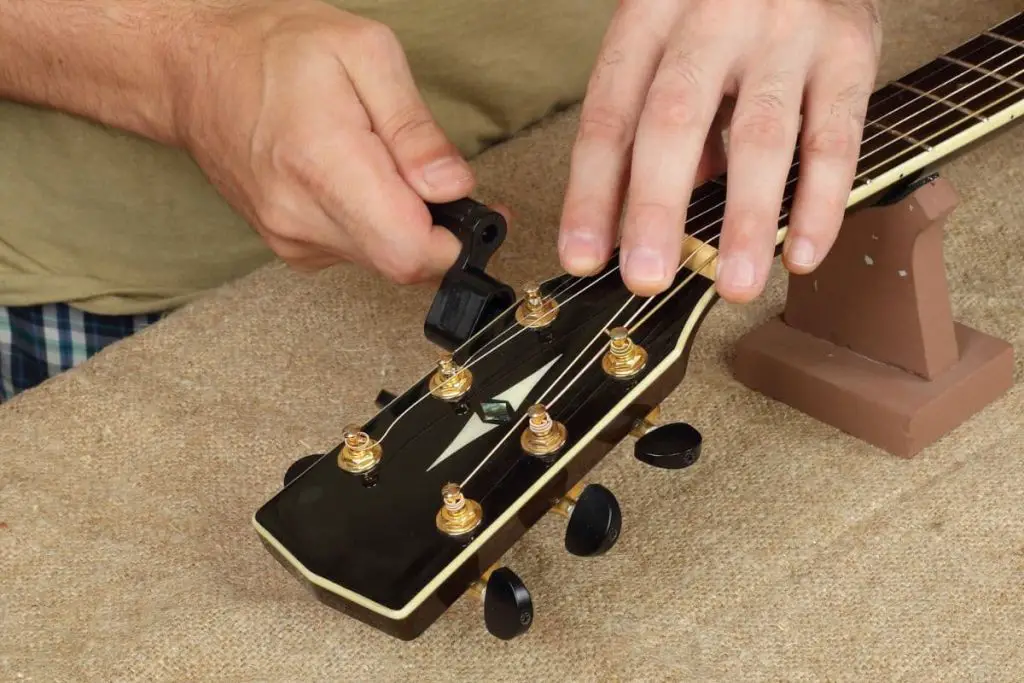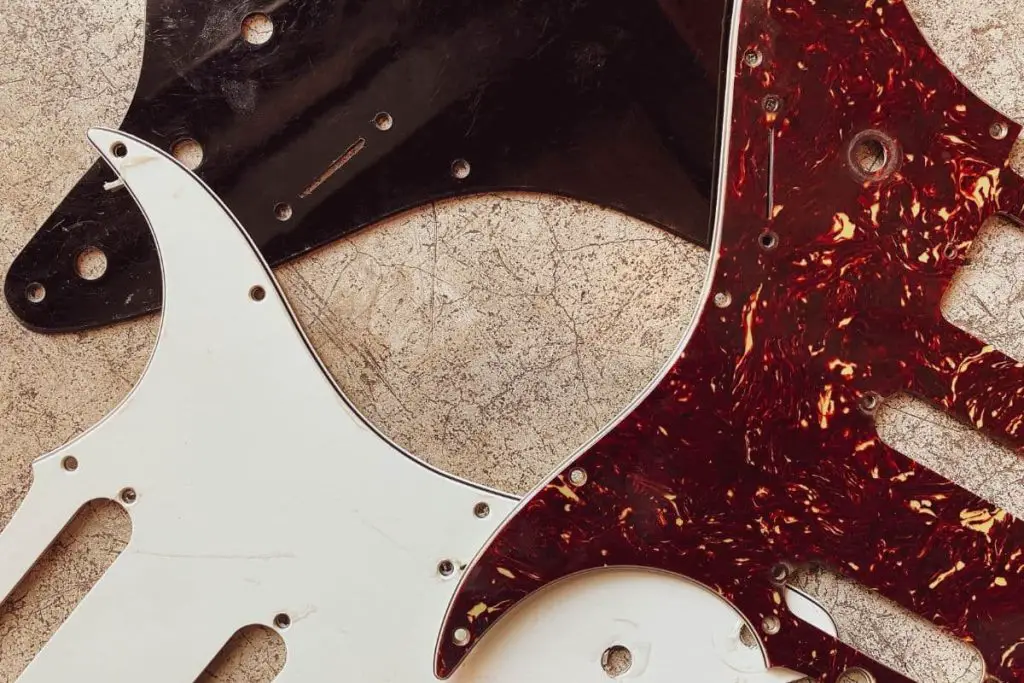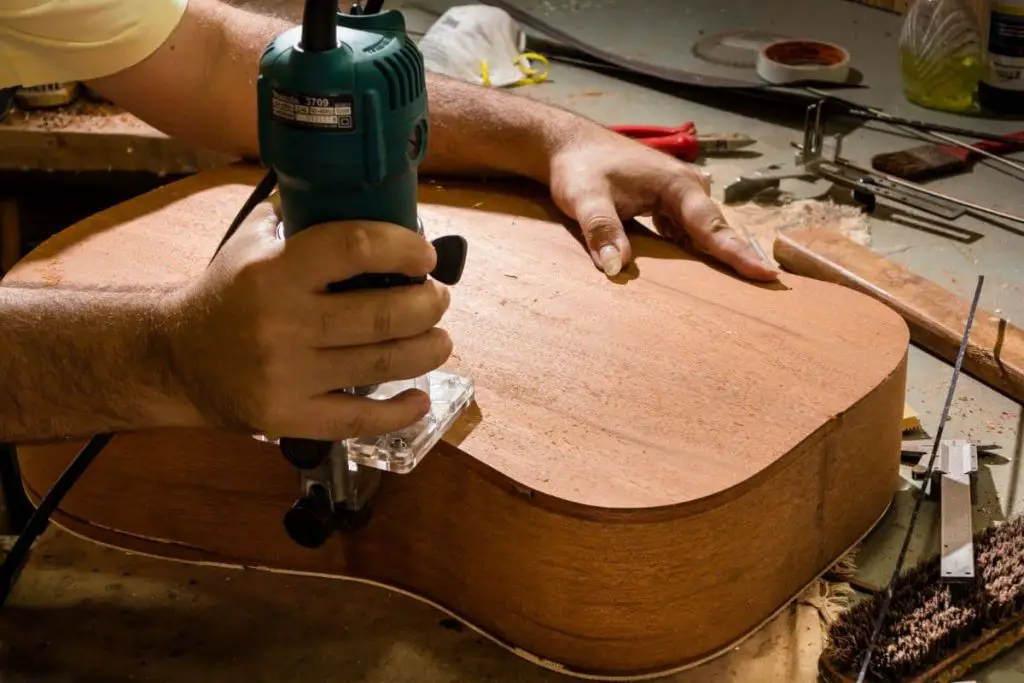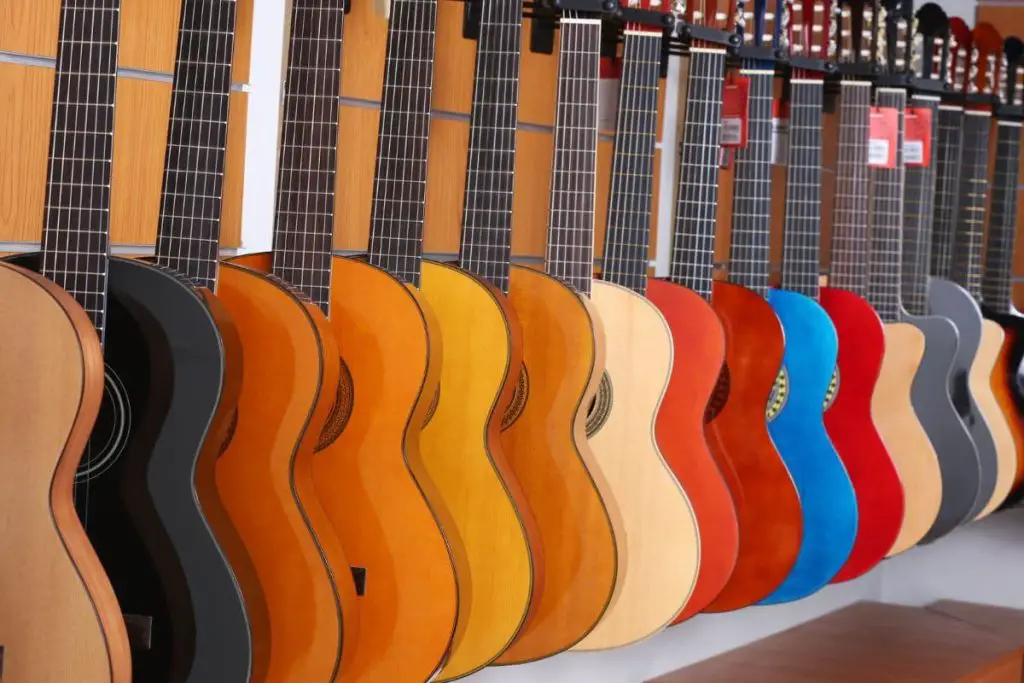Many people own guitars that are much too heavy for them. And, unfortunately, this makes it difficult to play it as often and for as long as you’d like. Luckily, there are ways to make your guitar less heavy.
To make your guitar less heavy, use a wider or an elastic strap and replace heavy hardware with lighter ones. For a more significant weight reduction, consider replacing your guitar body with a lighter one, creating hollow chambers within the body of your current guitar, or simply trimming it.
In this article, I’ll discuss in detail the different ways to help you make your guitar less heavy. I’ll also examine the main factors that can make a guitar heavy. Let’s get started!
If you want to find out what my recommended guitar gear is, then here is what I recommend on Amazon:
- Fender Cutaway Acoustic-Electric Guitar Bundle (MY FAVORITE GUITAR)
- Snark SN-8 Super Tight All Instrument Tuner (Easiest Tuner I’ve Used)
- 6 String Acoustic Guitar Capo (Best CAPO for quick changes)
- Dunlop Max Grip 1.0mm Nylon Picks (Thick Guitar Pick So You Don’t Lose Grip!)
- Universal Guitar Stand (Cheap & Minimalist Guitar Stand I Recommend)
- Levy’s 2″ Wide Quick Adjust Guitar Strap (Best Guitar Strap For Any Level)
1. Use a Wider Guitar Strap
Changing your guitar strap is probably the simplest solution that you can try. While this doesn’t directly reduce the guitar’s weight, it does reduce its impact on you. The guitar’s weight is felt most around the shoulder area, where the strap bites into your body as you play standing.
With a thin strap, the weight is concentrated along its narrow width, causing increased discomfort which becomes even greater the longer you carry the guitar. However, if the strap is wide, the guitar’s weight will be spread across this wider surface. This will in turn spread the weight of the guitar across a wider surface area of the shoulder.
With this weight spread, the impact of the guitar’s weight on you will be significantly reduced.
2. Use an Elastic Guitar Strap
Another alternative is to use an elastic guitar strap. With an elastic strap, the impact of the guitar’s weight is also reduced. Since the pull of gravity accentuates the guitar’s weight, an elastic strap will reduce the effect of this pull, reducing the effect of the weight on your shoulders.
3. Replace Heavy Hardware With Lighter Hardware
Replacing any heavy hardware with lighter hardware isn’t something that may readily occur to many guitar players. Many don’t realize that though the individual weights of the hardware on the guitar may be seemingly insignificant, they can add up when taken as a whole.
Let’s look at some of the hardware that should be considered for changing:
Use Lighter Tuning Machines
Your guitar has at least four tuning pegs for a four-string bass guitar and six for regular guitars. If these tuning pegs are heavy, they can contribute to the overall weight of the guitar.
You should look for lighter tuning machines and combine this with plastic pegs. This will marginally reduce the weight contributing to the overall weight of your guitar.

Consider Using Lighter Pickups
Pickups are your guitar’s engine but also add to your instrument’s weight. Thankfully, you can now find brands that make lighter pickups.
You can easily switch to these without compromising on the sound quality of your instrument. These more lightweight pickups will contribute to the reduction in the weight of your guitar.
Switch to an Aluminum Bridge
If you have a guitar with a steel or brass bridge, this is one more place to shed some weight. Bridges made of aluminum will weigh less than those made of steel or brass, so changing to these will further contribute to your goal of achieving a lighter weight for your guitar.
Use Plastic Knobs
Some guitar knobs can be pretty heavy. This applies mainly to those made of any kind of metal. When the knobs are three or more, this weight can add up. Since they add no real value to the guitar, you can change them to plastic ones to cut off some weight.
Remove the Neck Plate
If you own a guitar with a bolt-on neck, you’ll notice that there is a metal plate around the neck area. If you’ve taken off other hardware and still need to reduce more of your guitar’s weight, then you should take this off. Don’t worry – you won’t be putting your guitar in any danger.
While guitar players may argue that the plate does add some tonal value to your guitar, you can rest assured that the value you’ll be gaining from your lighter guitar will outweigh whatever tonal value the neck plate may offer.
Remove the Pickguard
Your pickguard serves two purposes on the guitar:
- It protects the guitar body from getting scratched as you strum with your guitar pick hence the name – pickguard.
- It acts as part of your guitar’s aesthetic design.
If you consider the above functions to be things you can do without, consider removing this guard. While what you see may be plastic, in many cases, there may be a metal lining that will contribute to the guitar’s overall weight.
It’s important that you combine all the tips listed above for the best outcome. The weight reduction each component offers will likely be insignificant in itself. However, when all of these tips are combined, you will achieve a more obvious weight reduction.
The next set of tips that I’ll be going over will deliver considerable weight reduction. They are, however, more drastic and may not be suitable for every guitar. They may also not be tasks that every guitar player can handle.
For example, if you own an expensive guitar or a model that’ll be worth a lot of money down the line (like the Les Paul or a 52 Telecaster), you surely wouldn’t consider making such drastic modifications.

4. Create a Chambered Body
Creating a chambered body means boring holes or creating spaces within the guitar body. This is a technique used by Gibson on its Les Paul brand. On the Les Paul, you won’t see these holes because they are covered with caps and finished to appear like it’s a completely solid body.
These holes are located along the face of the guitar body where there are no electronics. They reduce the overall density of the tonewood and, by implication, its weight. You can significantly reduce any guitar’s weight if you can bore up to eight or nine holes. These holes can either be bored through or bored out partially.
Whether bored out entirely or partially, you can choose to cover the holes with lighter wood, or you can leave them open as a design. Should you choose to leave them open, you’d have to smoothen them and finish them appropriately.
Another place you can bore the holes is along the edge of the guitar body. You can bore as many holes as possible and as deep as you can go without hitting the electronics. These holes will also significantly reduce the weight of the guitar and can also be covered or left open. It’s a matter of personal taste.
Check out this helpful YouTube video on how Ben of Crimson Custom Guitars creates chambers on the side of a guitar:
5. Shave Off Part of the Guitar
Aside from creating chambers in your guitar body, shaving some part of the guitar off is another way to reduce weight. To achieve this, follow the steps below:
- Remove the neck. This will only be possible with a bolt-on neck.
- Remove all electronics and hardware.
- Remove ¼ of an inch (0.63 cm) off the guitar’s top using a planer.
- Smooth and finish the new surface.
- Re-attach the neck.
- Reinstall the hardware and electronics.
- Restring your guitar and complete the setup.
Just as with boring holes in the guitar, this is not for the faint of heart and certainly not something to be done on every guitar.
6. Trim Your Guitar Body
Trimming your guitar body is another method that will drastically alter the state of your guitar. Trimming your guitar implies reshaping it by cutting off some parts around it, which will result in a smaller guitar body that will most definitely be lighter than it was.

According to Andrew Allan, an expert at building custom guitars and repairing, modifying, and rebuilding already finished guitars, the easiest type of guitar to work on to get the most weight off is a guitar with a bolt-on neck. This is because you can take off the neck and perform any or all of the three modifications (shaving off a ¼ inch/0.63 cm, creating chambers or trimming the guitar) mentioned above.
For a set neck or through neck, you can only create chambers in addition to using wider, elastic straps and switching to lighter hardware. You can watch a full video of Andrew discussing this subject here:
7. Change Your Guitar’s Body
The final solution you can consider is to completely change the body of your guitar to a suitably lighter one. You can buy practically any kind of guitar body that you want, and they can be purchased from custom shops or established guitar brands. Therefore, you’ll be able to pick a weight you’ll be comfortable with.
Before you change your guitar body, you must understand that your guitar’s body will affect how it sounds and how easy it’ll be for you to play it. While weight is an important consideration factor, it isn’t the only thing you should consider.
You should also consider factors such as:
- Resonance: This refers to the ability of the guitar body to vibrate at the frequency of the strings. A guitar body that resonates well will be preferable to one that doesn’t resonate well.
- Playability: This is where factors like weight come in. In addition to weight, you should also consider how easy it is to fret your chords while sitting and standing.
- Guitar body shape: This adds to the playability of a guitar. Your ability to access certain frets on your guitar will depend on its shape. Some shapes will make access to the frets close to the body more difficult, while others will make it easy.
The main reason why the body of the guitar is a major determinant of the weight is because it constitutes the bulk of the guitar. Therefore, the type of wood the body is made of will seriously affect its weight.
My reference to the type of wood above is referring to the density of the wood used in constructing the guitar. You can refer to this article to help you know how dense (or heavy) different types of wood can be.
All of the methods that deal with significant body modifications require specialized tools and the requisite skills to use said tools. It is, therefore, not something that just anyone can do.
Therefore, unless you’re really interested in learning how to build guitars and also willing to risk irreparable damage to your guitar, it may be a better and much safer option to have a professional carry out these modifications for you.
From what I’ve discussed so far, it’s clear that several factors can affect a guitar’s weight. That being said, what one person may consider heavy, may not be heavy to another.
In the following section, I’ll go over what is considered a “heavy” guitar, and some weight considerations to consider when choosing one.
What Is Considered a Heavy Guitar?
A guitar can be considered heavy if it weighs over 4kg or 9 pounds. Guitars will generally weigh between 6 and 12 pounds (2.72-5.44 kg). As such, those weighing in the upper limit of 9 to 12 pounds (2.72-5.44 kg) can be considered heavy guitars.
As I’ve already mentioned above, the issue of guitar weight can be pretty subjective. To this end, though we’ve looked at what can generally be considered a heavy guitar, I’ll provide a simple list of factors you should consider (with regards to weight) when choosing a guitar.
Factors To Consider When Choosing a Guitar – Weight Considerations
Whether you want to pick out a completely new guitar or you want to get a replacement body to achieve a lighter guitar, there are essential things you need to consider when making this choice.
The Guitar’s Tonewood
As I’ve already mentioned above, tone wood is the single most crucial factor to consider. The wood the guitar is made of will determine how heavy it will be. To put things in proper perspective, a guitar body made of rosewood will be much heavier than one made of a lighter tonewood like alder.
However the wood type contributes more than weight to the overall outcome of the guitar. There are other factors such as tonal color, durability, and aesthetics to consider. All these have been well documented for you in this guide on Guitar Tone Woods by Sound Unlimited.

The Guitar Body Type
Another essential thing to look at is the type of body your guitar of choice has. There are different facets to consider in this respect. These include body shape and constitution (solid, semi-hollow, or hollow).
Solid guitar bodies will most likely be significantly heavier than guitars with semi-hollow or hollow bodies. I’ll go more in-depth into the different body types in the following sections.
Body Shape Design
Some body shape designs will have a larger surface area than others. If you combine this with the effect of the choice of tonewood, then you’ll automatically see the impact that this will have.
A guitar with a wider body design will require more wood which will mean more weight.
Therefore, it’s safe to say that you should choose a guitar body with a streamlined design if weight is something you want to cut to the barest minimum.
Solid Body
Solid-body guitars will always weigh more than other body types. Unfortunately, you may not always have the option of choosing a different body type, especially when you want to achieve a specific tonal color.
However, it’s worth pointing out that some of the other options listed below will most definitely offer much lighter alternatives, albeit with some tonal differences.
Semi-Hollow Body
This type of guitar body is a cross between a hollow and solid body guitar. It’s almost like getting a guitar with the chambering already done. A semi-hollow body guitar won’t weigh as much as a solid body guitar.
As I noted earlier, there are tonal differences that such a body will have, and you may also experience some level of feedback in certain situations. However, this is something that an experienced audio engineer should be able to deal with easily.
Hollow Body
A hollow body guitar is an acoustic guitar with electronics. This will be super light but also very much tonally removed from your regular solid body electric guitar. In this case, your primary consideration will be the genre of music you play. However, this type of guitar is also notorious for its feedback issues.
The Type of Hardware Installed in the Guitar
This is something I’ve already discussed extensively above. You should be sure to pay attention to these when choosing a new guitar. While you can change them later, finding one with the type of hardware you want will save you the additional cost of purchasing the new ones and the task of changing them.
Why is my guitar so heavy?
Some possible reasons why your guitar may be heavy include:
- Solid body construction: Solid body guitars, such as the Les Paul or Telecaster, are made from a solid block of wood and can be heavier than other types of guitars, such as semi-hollow or hollow body guitars.
- Large body size: Guitars with larger body sizes, such as jumbo acoustics, can be heavier than smaller guitars, such as parlor acoustics or thin-line electrics.
- Heavy hardware: The hardware and electronics on a guitar, such as the tuners, bridge, and pickups, can add weight to the instrument.
- Heavy strings: Using heavier gauge strings can make the guitar feel heavier, as the increased tension can require more force to fret and play.
While a heavy guitar may be uncomfortable to play for extended periods of time, it’s important to remember that weight alone does not necessarily determine the quality or playability of the instrument. Some players prefer the feel of a heavier guitar, as it can provide more sustain and a richer tone.
If you find that your guitar is too heavy for your liking, there are some steps you can take to make it more comfortable to play, such as using a wider strap for better weight distribution or choosing a lighter guitar with similar features and tone.
Why are some guitars heavier than others?
Guitars can be heavier or lighter than others due to a variety of factors, including the materials used in the construction of the guitar, the shape and size of the body, and the hardware and electronics installed on the instrument.
Some possible reasons why some guitars are heavier than others include:
- Solid body construction: Solid body guitars, such as the Les Paul or Telecaster, are made from a solid block of wood and can be heavier than other types of guitars, such as semi-hollow or hollow body guitars.
- Large body size: Guitars with larger body sizes, such as jumbo acoustics, can be heavier than smaller guitars, such as parlor acoustics or thin-line electrics.
- Heavy hardware: The hardware and electronics on a guitar, such as the tuners, bridge, and pickups, can add weight to the instrument.
- Type of wood: The type of wood used in the construction of the guitar can also affect its weight. For example, a guitar made from dense and heavy woods such as mahogany or ebony will be heavier than one made from lighter woods such as alder or basswood.
- Finish: The type of finish used on the guitar can also affect its weight. A thick or heavy finish will add weight to the guitar, while a thin or light finish will not.
What weight is heavy for a guitar?
The weight that is considered “heavy” for a guitar can vary depending on the individual player and their personal preferences. Generally, a guitar weighing over 9 pounds (4.1 kg) can be considered heavy, but again, this can vary depending on factors such as the size and shape of the guitar and the player’s strength and endurance.
What is the heaviest guitar wood?
The heaviest wood commonly used for guitars is typically considered to be Brazilian Rosewood (Dalbergia nigra), which is known for its rich, warm tone and beautiful appearance. This wood is also very dense and heavy, and can add significant weight to a guitar.
Other woods that are known for their weight and density include African Blackwood (Dalbergia melanoxylon) and Cocobolo (Dalbergia retusa), which are also prized for their tonal characteristics and visual appeal.
While heavier woods can add to the sustain and overall sound quality of a guitar, it’s important to keep in mind that the weight of a guitar is not the only factor that determines its playability and sound quality. Factors such as the build quality, electronics, and overall design are also important considerations when choosing a guitar.
It’s also worth noting that many of these woods are protected by international trade regulations due to concerns over deforestation and illegal logging. As a result, some guitar manufacturers have turned to alternative materials, such as sustainable or synthetic woods, to achieve similar tonal characteristics without contributing to environmental damage.
How heavy is the average guitar?
For electric guitars, the average weight is around 7 to 8 pounds (3.2 to 3.6 kg), while acoustic guitars can range from 3 to 6 pounds (1.4 to 2.7 kg) for smaller travel-sized guitars, to 7 to 10 pounds (3.2 to 4.5 kg) for larger models.
It’s important to keep in mind that the weight of a guitar can affect its playability and comfort, especially during extended playing sessions or live performances. Some players may prefer a lighter guitar for its ease of use, while others may prefer a heavier guitar for its sustain and tone.
Ultimately, the best guitar for an individual player is one that feels comfortable and sounds good to them, regardless of its weight or other characteristics. It’s always a good idea to try out different guitars and see what feels and sounds best for you.
If you want to find out what my recommended guitar gear is, then here is what I recommend on Amazon:
- Fender Cutaway Acoustic-Electric Guitar Bundle (MY FAVORITE GUITAR)
- Snark SN-8 Super Tight All Instrument Tuner (Easiest Tuner I’ve Used)
- 6 String Acoustic Guitar Capo (Best CAPO for quick changes)
- Dunlop Max Grip 1.0mm Nylon Picks (Thick Guitar Pick So You Don’t Lose Grip!)
- Universal Guitar Stand (Cheap & Minimalist Guitar Stand I Recommend)
- Levy’s 2″ Wide Quick Adjust Guitar Strap (Best Guitar Strap For Any Level)
Related Posts:
- Classical vs Acoustic Guitar for Child: Which Is Better?
- How To Get Low Action Without Fret Buzz
- What To Do When a Whammy Bar Keeps Falling Out? (Loose Tremolo)
- How To Make Any Acoustic Guitar Louder (10 Ways)
- Why Is Your Acoustic Guitar So Quiet? 6 Reasons
- Why Does Your Acoustic Guitar Sound Tinny? 10 Fixes
- Should You Start With Acoustic Guitar? How to Decide
- How Do Guitar Chords Work? Music Theory Explained
- How To Know When To Change Guitar Chords in a Song
- Best Acoustic Guitars

